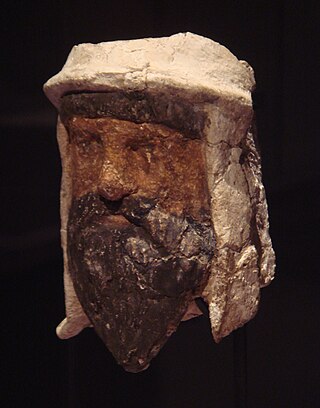
Tajikistan harkens to the Samanid Empire (819–999). The Tajik people came under Russian rule in the 1860s. The Basmachi revolt broke out in the wake of the Russian Revolution of 1917 and was quelled in the early 1920s during the Russian Civil War. In 1924, Tajikistan became an Autonomous Soviet Socialist Republic of the Soviet Union, the Tajik ASSR, within Uzbekistan. In 1929, Tajikistan was made one of the component republics of the Soviet Union – Tajik Soviet Socialist Republic – and it kept that status until gaining independence 1991 after the dissolution of the Soviet Union.

Bukhara is the seventh-largest city in Uzbekistan by population, with 280,187 residents as of 1 January 2020. It is the capital of Bukhara Region. The mother tongue of the majority of people of Bukhara is the Tajik dialect of the Persian language, although Uzbek is spoken as a second language by most residents.

The Khanate of Kokand was a Central Asian polity in the Fergana Valley centred on the city of Kokand between 1709 and 1876. Its territory is today divided between Uzbekistan, Kyrgyzstan, Tajikistan, and Kazakhstan.

Darvaz, alternatively Darwaz, Darvoz, or Darwoz, or the Darvaz Khanate was an independent Pamiri principality until 1878, ruled by a Mir and its capital was at Qal'ai Khumb. The principality controlled territory on the left and right banks of the Oxus River. The major settlements of Darvaz were Qal'ai Khumb and Kham.

The Khanate of Khiva was a Central Asian polity that existed in the historical region of Khwarazm from 1511 to 1920, except for a period of Afsharid occupation by Nader Shah between 1740 and 1746. Centred in the irrigated plains of the lower Amu Darya, south of the Aral Sea, with the capital in the city of Khiva. It covered present-day western Uzbekistan, southwestern Kazakhstan and much of Turkmenistan before the Russian conquest at the second half of the 19th century.

The Emirate of Bukhara was a Muslim polity in Central Asia that existed from 1785 to 1920 in what is now Uzbekistan, Tajikistan, Turkmenistan and Kazakhstan. It occupied the land between the Amu Darya and Syr Darya rivers, known formerly as Transoxiana. Its core territory was the fertile land along the lower Zarafshon river, and its urban centres were the ancient cities of Samarqand and the emirate's capital, Bukhara. It was contemporaneous with the Khanate of Khiva to the west, in Khwarazm, and the Khanate of Kokand to the east, in Fergana. In 1920, it ceased to exist with the establishment of the Bukharan People's Soviet Republic.

The Khanate of Bukhara was an Uzbek state in Central Asia from 1501 to 1785, founded by the Abu'l-Khayrid dynasty, a branch of the Shaybanids. From 1533 to 1540, Bukhara briefly became its capital during the reign of Ubaydallah Khan. The Khanate reached its greatest extent and influence under its penultimate Abu'l-Khayrid ruler, the scholarly Abdullah Khan II.

Nasrullah Khan, or Amir Muhammad Nasrullah Bahadur Khan, was the Emir of Bukhara from 24 April 1827 to 20 October 1860. His father was Emir Haydar bin Shahmurad (1800–1826).
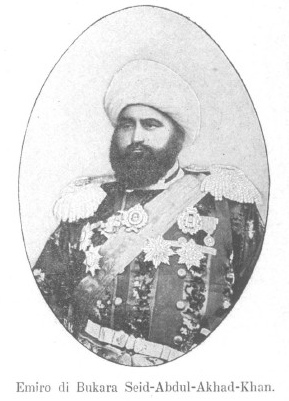
Said Abd al-Ahad Khan was the 7th Emir of the Uzbek Manghit dynasty, the last ruling dynasty of the Emirate of Bukhara, which at the time was a part of the Russian Empire. He ascended to the title aged 26 upon the death of his father, Muzaffar bin Nasrullah, on 12 November 1885.

The Bukharan People's Soviet Republic was a Soviet state that governed the former Emirate of Bukhara during the years immediately following the Russian Revolution. In 1924, its name was changed to the Bukharan Socialist Soviet Republic. After the redrawing of regional borders, its territory was assigned mostly to the Uzbek SSR and some to the Turkmen SSR.
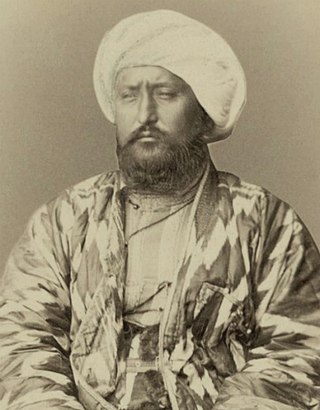
Sayid Muhammad Khudayar Khan, usually abbreviated to Khudayar Khan, was a Khan of Kokand who reigned between 1845 and 1875 with interruptions. He was the son of Shir Ali Khan. During the reign of Khudayar Khan, the Khanate was suffering from a civil war and from interventions of the Emir of Bukhara. Subsequently, the Russian invasion into Central Asia first forced the Khanate to become a vassal of the Russian Empire, and in 1876 the Khanate was abolished as a result of the suppression of an uprising. In 1875, Khudayar Khan, who took a pro-Russian position, during the uprising had to flee to Orenburg in Russia. He died in exile.
Muhammad Ali Khan, commonly referred to as Madali Khan, was the official Khan of Kokand from c. 1822 to 1842. He became the official ruler of Kokand at the age of 14 after his father Muhammad Umar Khan died of an illness in 1822, although some sources claim his mother Mohlaroyim was really in charge due to Madali's young age and inexperience.
Haydar bin Shahmurad was the Uzbek Emir of Bukhara from 1799 to 1826. His father was Emir Shahmurad. (1785–1799). After the death of Shah Murad in December 1799, Haydar bin Shahmurad came to power.
Shah Murad, also known as Beg-i Jan, alternatively titled Amir al-Mu'minin, Amir Ma'sum Ghazi or Padishah Ghazi in Bukharan historiography, was the first Amir of the Emirate of Bukhara from 1785 to his death in 1799. His father was Ataliq Daniyal Biy (1758–1785). After Daniyal Biy's death, Shah Murad came to power.
Mir Hussein bin Haydar (1797–1826) was the Uzbek Emir of Bukharan Emirate from October to December 1826. His father was emir Haydar bin Shahmurad (1800–1826). Emir Haydar died in October 1826 and was succeeded by his son Mir Hussein bin Haydar.
Umar bin Haydar was the Uzbek Emir of Bukhara from December 1826 to April 1827. His father was emir Haydar bin Shahmurad (1800–1826).
Daniyal Biy was the Uzbek ruler (atalyk) of Bukhara from 1758 to 1785. His father was Khudoyar biy. The previous ruler of the Bukharan Khanate, Muhammad Rahim Khan, died in 1758 and was succeeded by Daniyal Biy, his uncle.

Bukhara slave trade refers to the slave trade in the city of Bukhara in Central Asia from antiquity until the 19th-century. Bukhara and Khiva was known as the major centers of slave trade in Central Asia for centuries, until the Russian conquest of Central Asia in the late 19th-century.
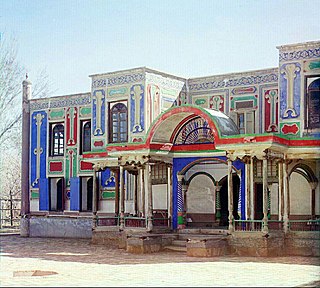
Shirbudun Palace is a palace complex in Bukhara, Uzbekistan, that served as one of the political centers of the Bukhara emirs. The construction of the palace began around 1870 during the rule of Muzaffar bin Nasrullah (1860–1885) in the Bukhara Emirate. In the 1870s, under the direction of the architect Abdurasul and the plasterer Rahim Hayotov, the palace complex, including the palace itself, a reception hall, a pool, a mosque, and other buildings, was built in Shirbudun. The external appearance of the palace reflects architectural features from Iran and Europe. During the reign of Emir Abd al-Ahad Khan, several palace chambers and elegant halls were added to the palace.
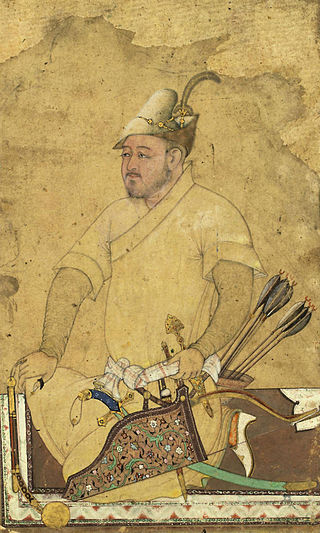
Traditionally, it is believed that there are 92 clans and tribes of Uzbeks in the old sense of the term of nomadic Desht-i-Kipchak origin. As the modern historian T.Sultanov has established, these 92 "tribes" include "the names of the majority of Turkic and some non—Turkic ethnic groups that inhabited Central Asia at that time".













